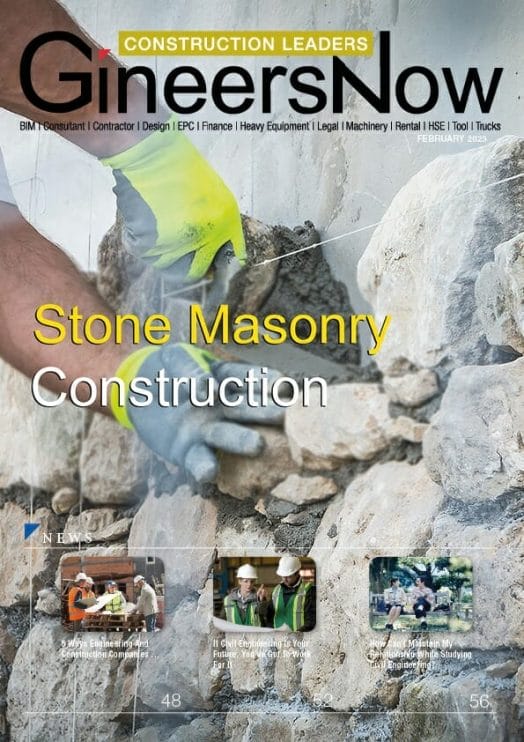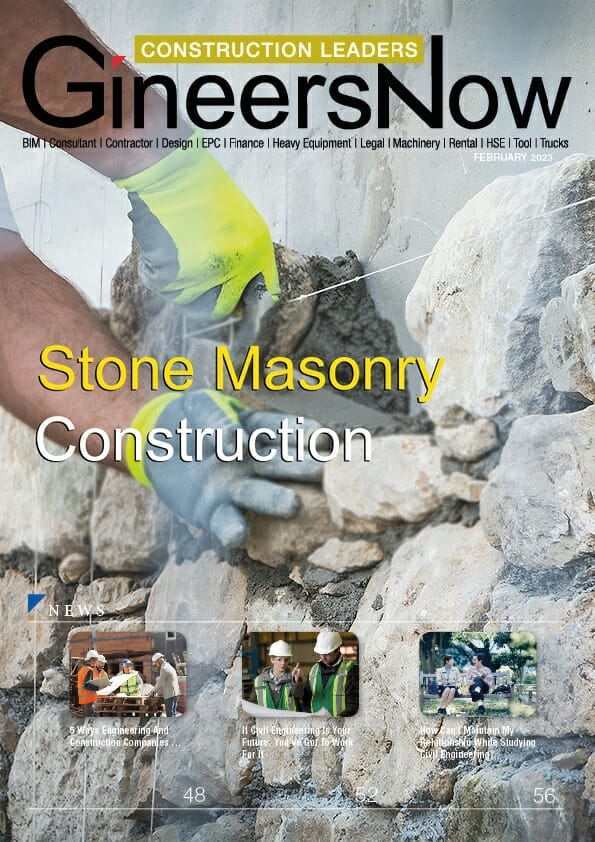Discover the latest advancements in stone masonry in construction and learn how they can enhance your next project’s aesthetic and structural integrity.
Stone masonry in construction is a form of building used since ancient times. It is a method that has been employed to construct everything from the Great Wall of China to beautiful churches and cathedrals throughout Europe. This article looks at the history, present, and future of stone masonry in construction, exploring how it has evolved over time and what new developments are coming in the future.
What is Stone Masonry in Construction
Stone masonry construction is a type of construction that has been used for centuries. It involves the construction of structures from individual stones, which are stacked, interlocked, and bonded together with mortar or cement. This construction is incredibly durable due to its ability to withstand extreme weather elements such as wind and rain.
The most common types of stone masonry include dry stone walling, ashlar masonry, and rubble masonry. Dry stone walling is usually found in rural areas where many loose stones are available. At the same time, ashlar masonry consists of finely cut blocks that fit tightly together with little to no apparent gaps. Rubble masonry involves randomly shaped stones that are fitted together using mortar or cement. Regardless of the type used, all forms of stone masonry require skillful manipulation to ensure a successful build.
Historical Perspective: Traditional Building Blocks
The traditional building blocks of construction have a long and prosperous history. Stone masonry in construction has been used for centuries to build the structures that define many cities worldwide. Stone has been an essential element in architecture since ancient times, as it is one of the strongest and most resilient materials available for construction.
Throughout its long history, stone masonry in construction has been used to create everything from homes and government buildings to churches and monuments. Some of the most famous examples include The Great Pyramid of Giza, built nearly 5,000 years ago; St. Peter’s Basilica in Rome; The Taj Mahal; and The Colosseum in Italy. These grandiose constructions demonstrate just how powerful stone masonry can be when combined with careful craftsmanship and attention to detail.
Modern Stone Masonry: Complex Structures
Modern stone masonry has become increasingly popular in recent years as more architects choose to incorporate it into their construction projects. Stone masonry is an ancient form of construction that can be traced back to the earliest civilizations in history. The practice involves using stones and rocks to create complex structural designs that are often beautiful works of art.
Today, modern stone masons employ various tools and techniques to craft intricate structures with lasting value. For example, some use traditional methods such as cutting stones with chisels or mallets. In contrast, others may incorporate newer technologies, such as laser cutters or CNC machines for precision-cut pieces. No matter the approach is taken, experienced stone masons take great pride in their craftsmanship and strive to bring out the unique beauty within each piece they work on.
Benefits of Stone Masonry: Strength and Beauty
Stone masonry has been around for centuries and remains one of the most popular construction methods. Stone masonry in construction is incredibly strong and durable and provides a stunning aesthetic that can’t be replicated with other materials.
When stone masonry is utilized in construction projects, it can bring about numerous benefits for the homeowner or business owner. Stone masonry offers more strength and resilience than other building materials, such as wood or brick.
Additionally, stone can last for many years because it can stand up against harsh weather conditions and natural disasters such as floods and earthquakes. Not only does stone provide superior protection from the outside elements, but its beauty will remain timeless even after years of wear and tear. Furthermore, stone provides excellent insulation, which helps maintain comfortable temperatures throughout the year while providing energy-efficient savings on cooling costs during the summer months.
Challenges in Stone Masonry: Cost and Time
Stone masonry in construction is a time-consuming and expensive endeavor. Working with natural stone requires specialized tools, skills, and materials that can drive up costs significantly. In addition, the labor involved in cutting, fitting, and setting the stones can take considerable time to complete a project.
The first challenge of stone masonry in construction involves sourcing appropriate material that meets design specifications and local building codes. Natural stone is generally sourced from faraway quarries, which adds to the cost of transporting it to the job site. Besides raw material costs, additional expenses are required for skilled workers who are experienced in correctly laying out patterns with varying sizes of stones for custom jobs such as monuments or walls.
The second major challenge involves proper installation methods, which require an exacting level of skill from the mason to place each piece precisely according to plan.
Sustainable Future for Stone Masonry
The future of stone masonry in construction is here and is more sustainable than ever. As we become more aware of the need to protect our environment and conserve resources, stone masonry has emerged as a viable option for green building projects. It has been used in many successful projects, from private homes to commercial buildings and public infrastructure.
Stone masonry offers several key advantages over other construction methods, including its natural ability to regulate temperatures and reduce energy costs. Additionally, due to its longevity, it requires less maintenance than traditional materials such as wood or metal, resulting in lower environmental impact over time. In addition, technological advances have enabled stone masons to use high-grade materials that are both strong and durable while maintaining their aesthetic appeal without compromising on quality or durability.
Latest Trends in Stone Masonry in Construction
Stone masonry in construction is an ancient form of building that remains popular today. This construction method uses large, carefully-cut stones to create a structure— typically walls and foundations. As with any other field, stone masonry in construction has seen its share of trends come and go over the years. Here’s the latest on what’s in vogue for stone masonry construction this season.
One of the biggest trends in stone masonry is decorative work. This can include carvings, etchings, and intricate designs that help add a personal touch to any project. In addition to being visually appealing, these elements can provide an extra layer of protection against natural elements such as wind or rain. Another popular trend is combining different types of stones to create unique visuals in projects like retaining walls or outdoor fireplaces.
Pros and Cons of Stone in Masonry Construction
Stone masonry construction has been used for centuries and is still a common practice today. It offers many advantages, such as versatility, durability, affordability, and fire resistance. However, it also carries some drawbacks that must be considered before building with stone masonry.
Advantages of stone masonry in construction
One of the main benefits of using stone masonry in construction is its versatility. Stone can be cut into shapes or sizes and painted or stained to match any desired color scheme. Stone walls are also durable, making them a good choice for long-term projects like retaining walls or foundations. Building with stone masonry can also be more cost-effective than other types of construction because stones are often abundant in nature and, thus, cheaper to acquire. Lastly, stone materials offer excellent fire resistance, making them ideal for areas prone to fires or high temperatures.
Disadvantages of stone masonry in construction
Stone masonry has been around since the earliest civilizations and is still used today, making it one of the oldest building methods. Despite its strength, longevity, and pleasing aesthetics, stone masonry in construction has drawbacks. Firstly, it is an incredibly labor-intensive process that requires specialized skill sets and a lot of time and effort. This makes it significantly more expensive than other modern construction methods, such as steel or concrete. Additionally, stone masonry is difficult to customize; individual blocks must be carefully cut and fitted together using mortar, which can be difficult to adjust if changes are needed later in the process. Lastly, working with large pieces of stone can be hazardous for workers due to the potential health risks from dust inhalation or vibration caused by machinery cutting or chiseling stones into shape.
Read GineersNow Construction Magazine for FREE
Editor’s Note
Discover the latest innovations and methods in stone masonry in construction. Learn how to use new tools and techniques to create beautiful, durable structures that last for generations.
Stone masonry in construction has been used in buildings since the beginning of civilization and is still widely used today. This article will explore the history of stone masonry in construction, examine how it’s currently being used, and discuss how it may be developed in the future. Stone masonry in construction involves using stones to build walls, floors, columns, and other structures. It’s a form of construction that takes skill and expertise to create strong, durable structures.
Stone masonry in construction is one of the oldest and most popular building methods in history, as it has withstood the test of time. Today, innovations have made this traditional form of architecture even more effective and efficient.

Using stone masonry in construction techniques use natural stone, such as granite or limestone, which is cut into blocks to make walls or foundations. It’s a method that requires precision and skill to ensure that it lasts many years. Recent developments in stone masonry in construction have allowed for faster installation times due to improved technology. This means that projects can be completed more quickly without sacrificing quality or durability. Additionally, new materials are also being used to improve energy efficiency by providing better insulation from cold temperatures and helping regulate humidity levels inside buildings.
Stone masonry in construction has a long and fascinating history and remains an important part of architecture today. Using new technology, modern stone masonry is becoming even more efficient and cost-effective than ever before. It is also highly durable and can be used to create beautiful structures that stand the test of time. Looking ahead, stone masonry looks set to remain a valuable asset in many construction areas for years to come.

Final Thoughts: Stone Masonry in Construction
In conclusion, stone masonry in construction is a timeless art form and an essential part of the world’s architectural history. Its importance is continually growing with the need to build more sustainable buildings. The future of stone masonry in construction will rely on utilizing new technologies, such as automation and robotics, to reduce costs and increase efficiency. Additionally, continuing education and training in this field will help ensure that masons remain skilled craftspeople who can meet modern design standards while preserving traditional methods.


















